moving average bounce trading system
The 200 day moving average (MA) is one of the most followed indicators.
Just tune in to financial news and you'll hear stuff like…
"The S&P has broken below the 200 day moving average — it's a bear market!"
"You should buy when the price cross above the 200 day moving average."
"Apple just closed below the 200MA — time to sell."
But here's the thing:
How does it help you as a trader?
It doesn't.
Instead, it toys on your emotion and causes you to buy/sell at the wrong time.
But don't worry, we're going to change all that.
Because in today's post, you'll discover…
- What is the 200 day moving average and how does it work
- How to use the 200MA and increase your winning rate
- How to better time your entries when trading with the 200MA
- How to ride massive trends without getting stopped out on the retracement
- How to identify the correct market cycle so you don't get caught on the wrong side of the move
Sounds good?
Let's get started now….
What is the 200 day moving average and how does it work?
The Moving Average (MA) is a trading indicator that averages the price data, and it appears as a line on your chart.
Here's how it works…
Let's assume over the last 5 days, Apple shares closed at 100, 90, 95, 105, and 100.
So, the 5-period MA is [100 + 90 + 95+ 105 +100] / 5 = 98
And when you "string" together these 5-period MA values together, you get a smooth line on your chart.
Now the concept is the same for the 200 day moving average.
The only difference is you look at the last 200 days of price data which gives you a longer-term moving average.
Here's how to plot 200 day moving average (on TradingView):
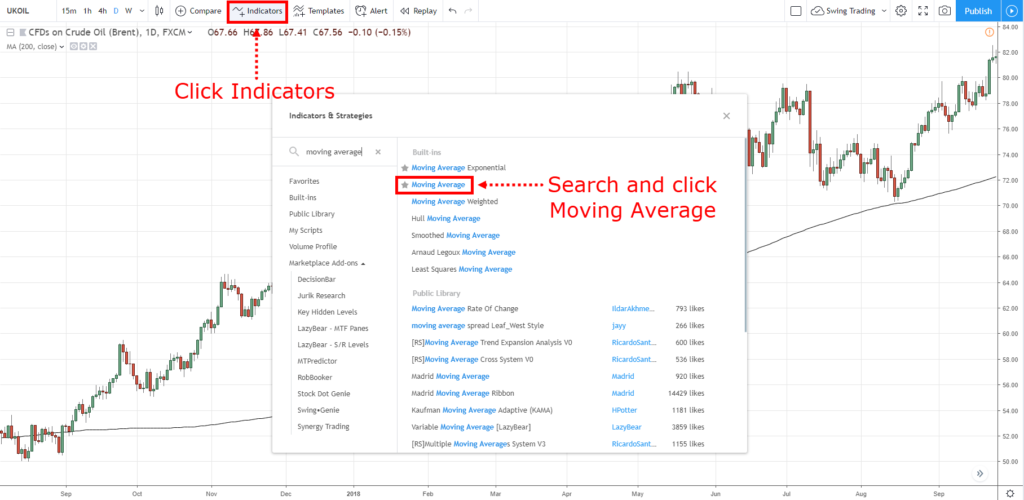
And here's how it looks like: A 200 day moving average chart
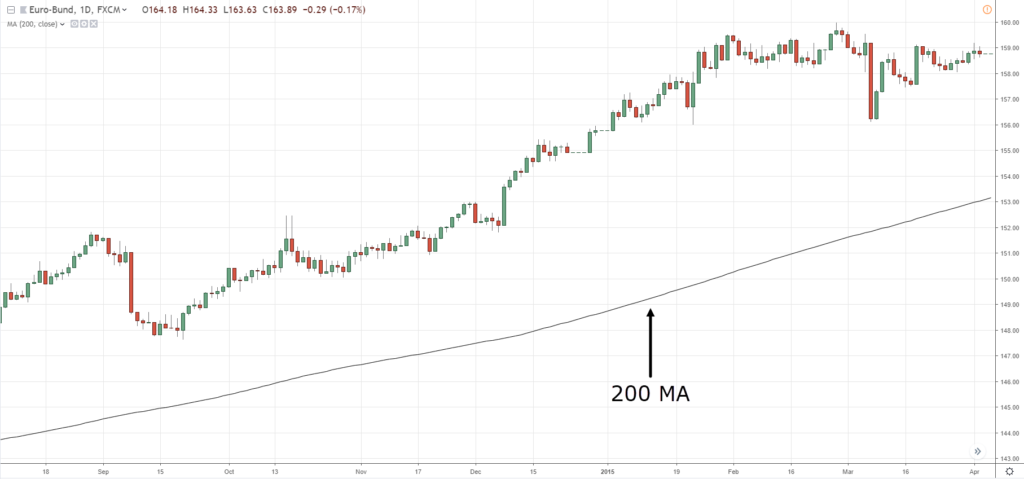
Now, there are different types of moving average like exponential, simple, weighted, etc.
But you don't have to worry about it because the concept is the same (only the way it's calculated is slightly different).
Let's move on…
How to use the 200 day moving average and increase your winning rate
Here's the thing:
The 200 day moving average is a long-term indicator.
This means you can use it to identify and trade with the long-term trend.
Here's how…
If the price is above the 200 day moving average indicator, then look for buying opportunities.
If the price is below the 200 day moving average indicator, then look for selling opportunities.
An example:
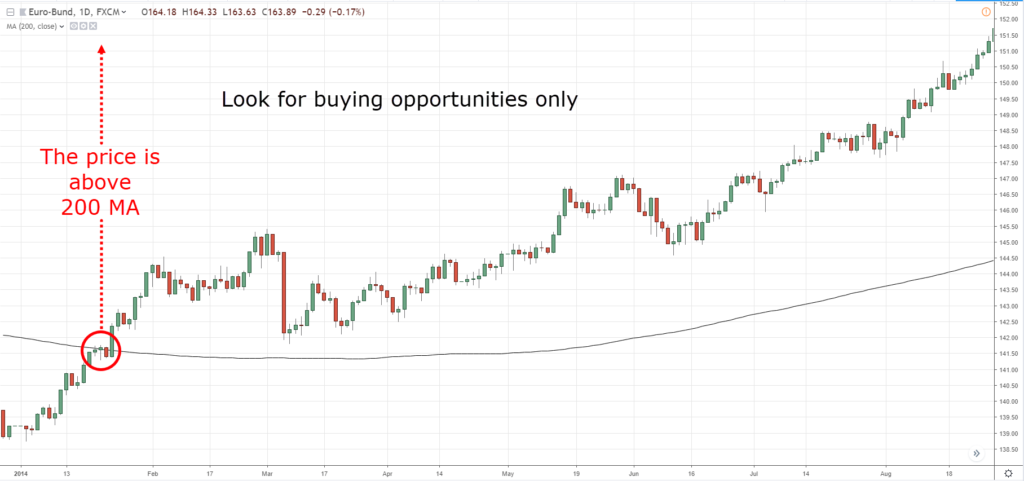
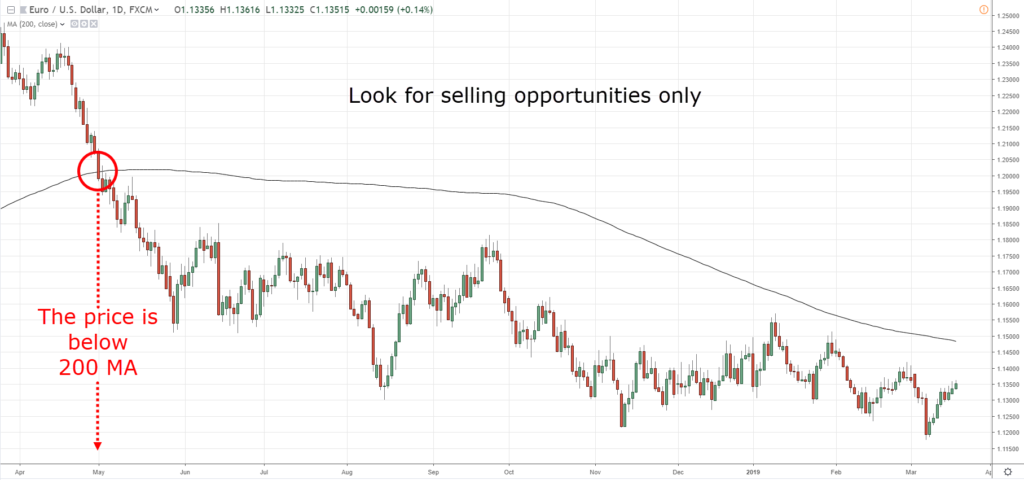
Pro Tip:
If you're trading stocks, you can refer to the index to get your trend bias.
So if the S&P 500 is above the 200 day moving average, then look for buying opportunities on US stocks.
This simple technique will increase your winning rate and reduce your drawdown.
How to better time your entries when trading with the 200-day moving average indicator
You're probably thinking:
"Okay it's not difficult to identify the trend. But when is the right time to enter a trade?"
Here are a few techniques you can use…
- Support and Resistance
- 200MA bounce
- Ascending triangle
- Bull Flag
I'll explain…
1. Support and Resistance
Support — an area on your chart where potential buying pressure could step in.
Resistance — an area on your chart where potential selling pressure could step in.
So, if the price is above the 200 day moving average, you can look for buying opportunities at Support.
Or if the price is below it, you can look for selling opportunities at Resistance.
Here's what I mean…
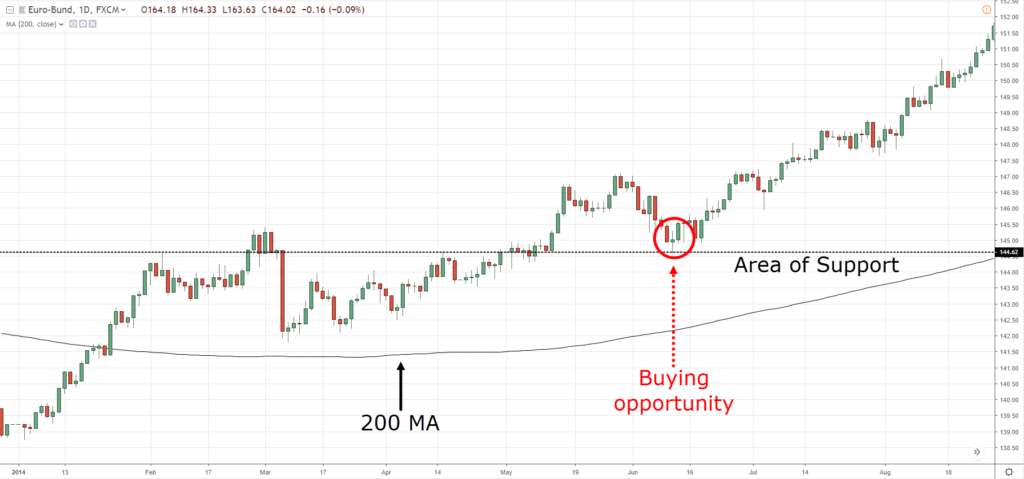
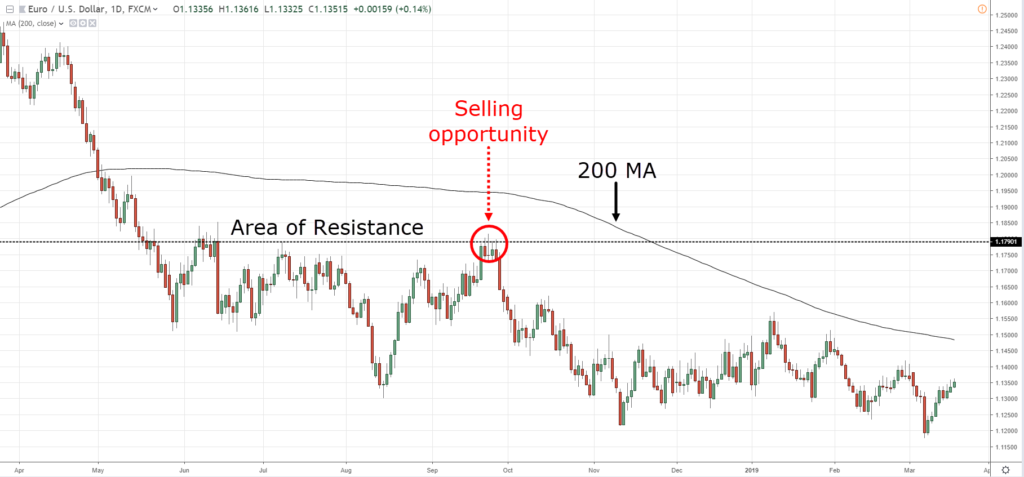
2. 200MA Bounce
In a weak trend, the 200 day moving average can act as an area of value.
You'll notice the price approach the 200MA and then "bounce" away — and this presents an opportunity to enter the markets.
Here's an example:
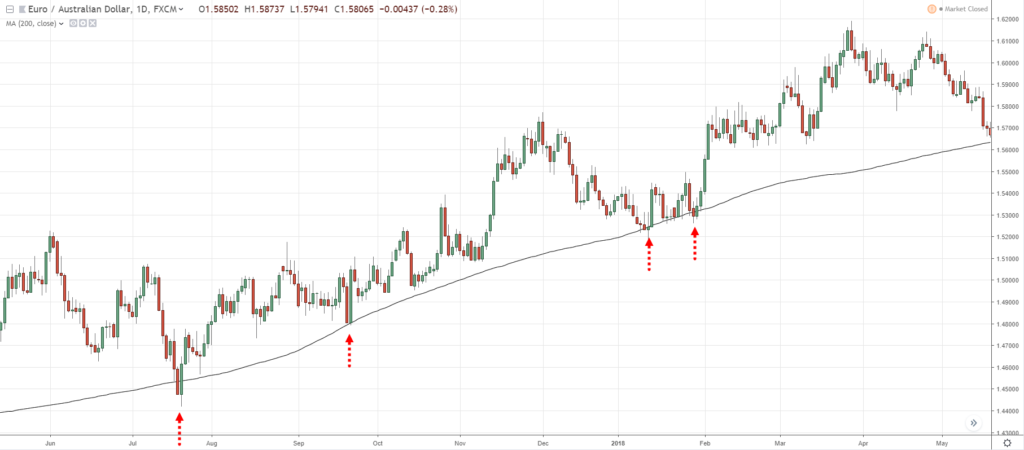
Pro Tip:
You get higher probability trades when the 200MA also coincides with nearby Support/Resistance.
3. Ascending Triangle and Descending Triangle
The Ascending Triangle is a bullish chart pattern.
It's a sign of strength as the buyers are willing to buy at higher prices (despite coming into Resistance).
So in an uptrend (the price above 200MA), you can look for an Ascending Triangle and buy the breakout.
And in a downtrend, look for a Descending Triangle and short the breakdown.
An example:
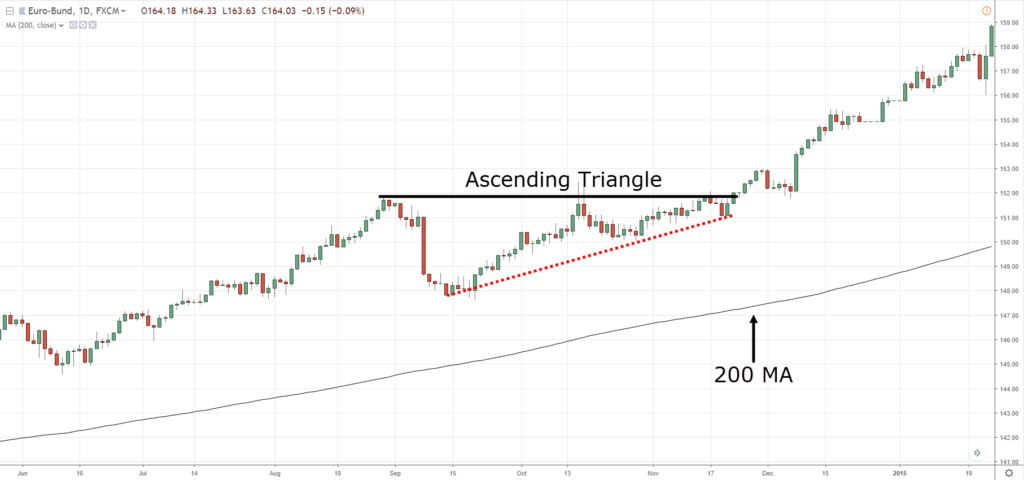
Pro Tip:
The longer the Ascending Triangle takes to form, the stronger the breakout.
4. Bull Flag
The Bull Flag is another bullish chart pattern.
It's a sign of strength as the buyers are in control and the sellers have difficulty pushing the price lower (that's why you have small bodied candles on the pullback).
So in an uptrend, you can look for a Bull Flag pattern and buy the break of the highs.
And in a downtrend, look for a Bear Flag pattern and short the break of the lows.
Here's what I mean…
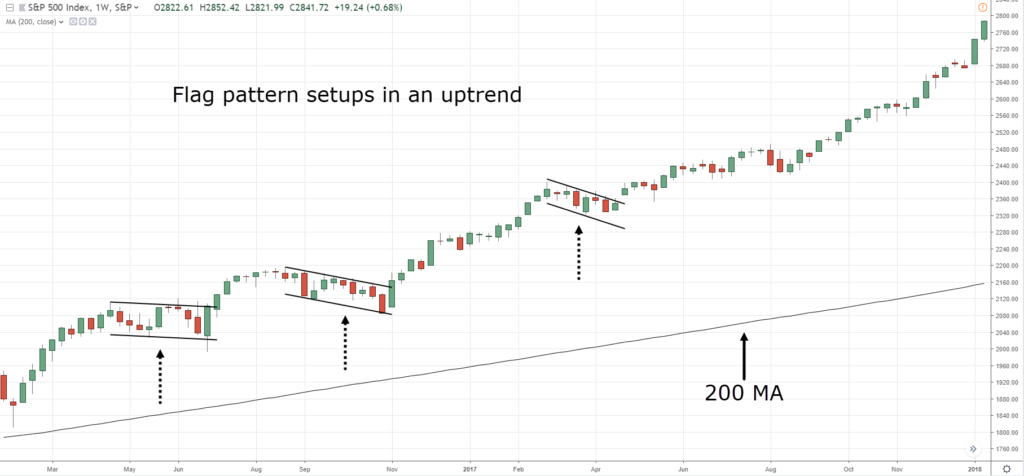
Pro Tip:
The best flag pattern to trade is when the price just broke out of a range (usually the first pullback).
200-day moving average: How to ride massive trends without getting stopped out on the retracement
Here's a fact:
If you want to ride massive trends in the market (the kind that gets other traders drooling), then you must give your trade room to "breath".
Having a tight trailing stop loss won't cut it.
Instead, you must give it a buffer.
And one way is to trail your stop loss with the 200-day moving average.
This means if you're long, then you'll only exit the trade when the price closes below the 200MA.
Or if you're short, then exit the trade only when the price closes above the 200MA.
Here's what I mean…

Pro Tip:
If you want to ride short-term trends, you can trail with the 20MA.
If you want to ride medium-term trends, you can trail with the 50MA.
How to identify the correct market cycle so you don't get caught on the wrong side of the move
Here's a fact:
The market is always changing.
It moves from a range to trend, trend to range, and etc.
You can break it down into 4 stages:
- Accumulation
- Advancing
- Distribution
- Declining
I'll explain…
(This is important so please study it)
1. Accumulation stage
The accumulation stage occurs after a downtrend.
It looks like a range market with obvious Support & Resistance.
You'll see the 200MA flatten and the price might "whipsaw" around it.
This tells you the buyer and sellers are in equilibrium and the market is undecided.
Here's an example:
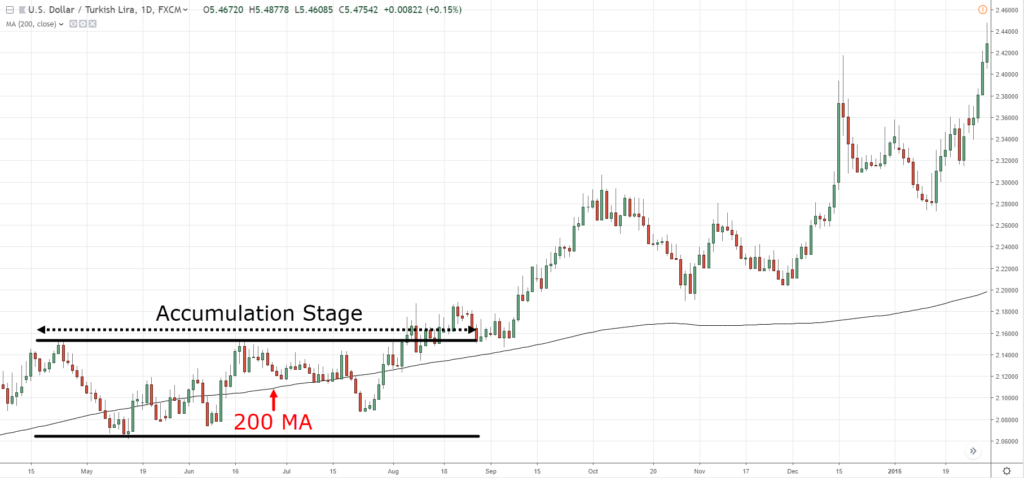
Now…
In an accumulation stage, the market could break out in either direction.
If it breaks down lower, the downtrend continues (and you can look for shorting opportunities).
But if it breaks higher, then it's the start of an uptrend which brings us to the next stage…
2. Advancing stage
The advancing stage occurs when the price breaks out higher of the accumulation stage.
It looks like an uptrend with higher highs and lows.
At this point, you'll see the price above the 200MA and the 200MA starts to point higher.
Here's an example:
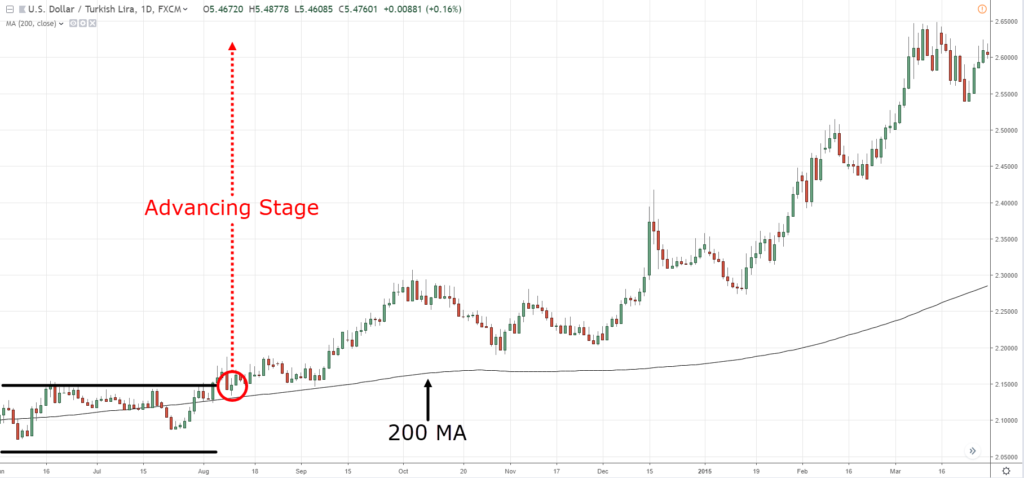
Now…
In the advancing stage, the path of least resistance is towards the upside, so you want to be a buyer (not a seller).
There are a few ways you can trade the advancing stage…
- Buy the first pullback of the accumulation stage
- Wait for a pullback towards previous Resistance turned Support
- Look for a pullback towards the Moving Average
If you want to learn more, check out The Trend Trading Strategy Guide.
Next…
3. Distribution stage
Here's the thing:
Markets don't go up forever.
Eventually, sellers would come in to push the price lower.
And the first sign of weakness is in a distribution stage.
It looks like a range market in an uptrend and you'll see the 200MA flatten and the price might "whipsaw" around it.
This tells you the buyer and sellers are in equilibrium and the market is undecided.
Here's an example:
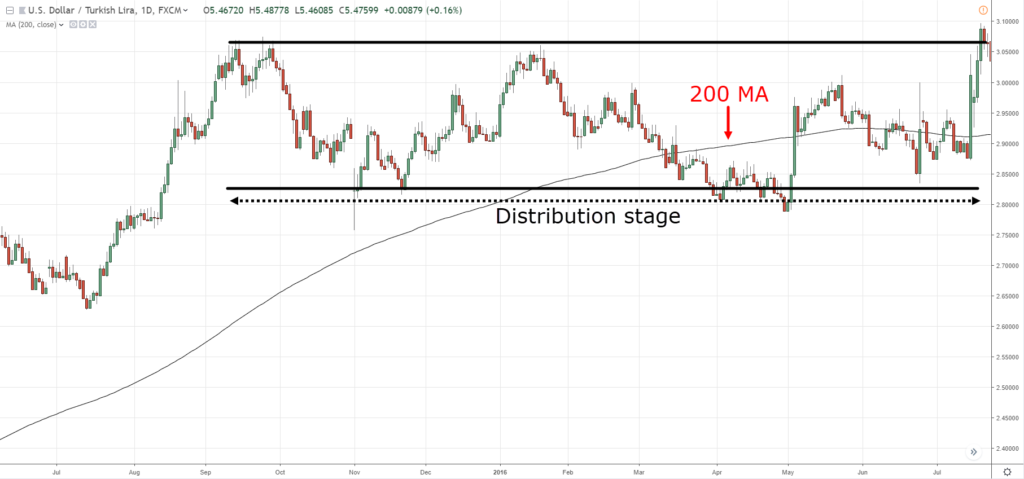
Now…
In a distribution stage, the market could break out in either direction.
If it breaks out higher, the uptrend continues (and you can continue to look for buying opportunities).
But if it breaks lower, then it's the start of a downtrend which brings us to the next stage…
4. Declining stage
This is the final stage of the market cycle.
The declining stage occurs when the price breaks down of the distribution stage.
It looks like a downtrend with lower highs and lows.
At this point, you'll see the price below the 200MA and the 200MA starts to point lower.
Here's an example:
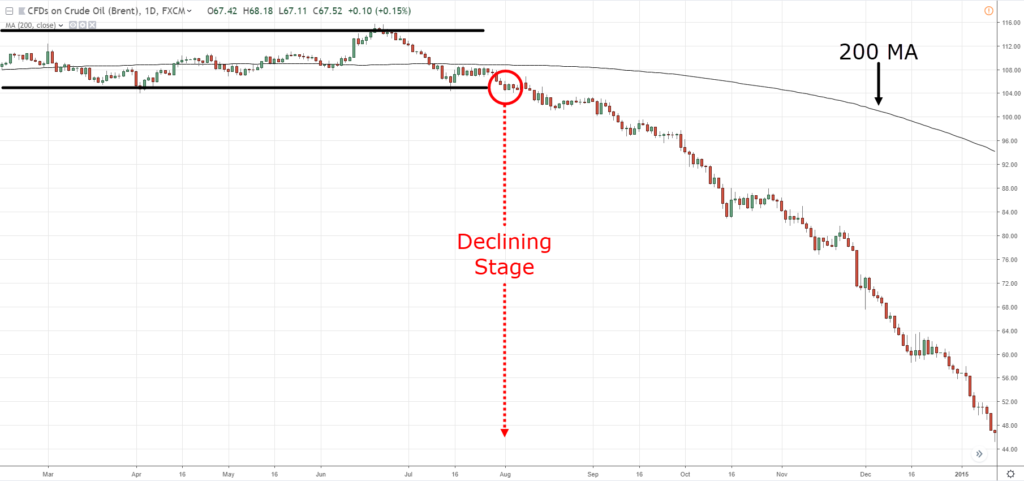
Now…
In a declining stage, the path of least resistance is towards the downside, so you want to be a seller (not a buyer).
Likewise:
A declining stage doesn't go on forever.
It'll come to a point where the price is low enough to attract buyers.
And that's where the market transit back to stage 1 — the accumulation stage.
One last thing…
The 4 stages of the market is more art than science.
Sometimes it's not clear which stage the market is in.
When that happens, your best bet is to move on to another market which makes more sense.
Conclusion
Here's what you've learned today:
- The 200 day Moving Average (MA) is a long-term trend following indicator
- You can use the 200MA as a trend filter. Look for buying opportunities when the price is above it and selling opportunities when the price is below it
- You can time your entries by trading at Support and Resistance, Moving Average, or chart patterns
- You can trail your stop loss with 200MA and ride massive trends
- The 200MA helps you identify the 4 stages of the market so you can better time your entries and exits
Now here's what I'd like to know…
How do you use the 200 day moving average in your trading?
Leave a comment below and share your thoughts with me.
moving average bounce trading system
Source: https://www.tradingwithrayner.com/200-day-moving-average/

0 Response to "moving average bounce trading system"
Post a Comment